Iloilo City, the capital of Iloilo Province in Western Visayas, has been gaining a lot of much-deserved attention in business, leisure, culture, and gastronomy, among many other fields. It has been considered one of the most liveable cities in the Philippines, and recently as PH’s new investment hotspot thanks to continuous development and the influx of investors. It was also recently named a UNESCO Creative City for Gastronomy—the only one in PH. If you’re considering places where you can retire back in the motherland, Iloilo City should be on your list.
It then comes as no surprise that tourism in what’s fondly dubbed the City of Love has been on the rise for years now. If you’re visiting PH for only a few weeks, you might want to consider a three-day or weekend trip to explore Iloilo City for the first time, whether to experience the Dinagyang Festival (which in 2024 is happening this weekend, Jan. 26-28) or to see if this is the PH city for you. There are many places to explore in Iloilo City, so we came up with this KUBO guide to help you prioritize and make the most of its rich history, culture, and cuisine—arranged by districts for easier planning and navigation.
Iloilo City Proper
1. Explore Old Downtown Iloilo
The city’s historic center is the focal point of Dinagyang Festival events, including a Food Festival, so expect it to be extremely crowded—yet loads of fun—during that time. If you’re visiting at any other time, drive or walk along the city proper’s streets to admire the beautiful arcade-type sidewalks and old buildings from the 1800s, with glorious architecture the city is endeavoring to restore.
Among the many spots you should check out downtown include:
Calle Real (now J.M. Basa Street), the city’s old central business district. Here you’ll find Regent Theater, once called Cine Palace, the oldest existing theater in the country; and the first shopping center in the Philippines. While there, you may also want to try Roberto’s siopao that Ilonggos are proud of and every visitor raves about. Get the Queen, the biggest size of their famous steamed buns filled with bacon, Chinese sausage, chicken and pork adobo, salted egg, and more. (Make sure to watch for our Iloilo food guides, coming soon!)
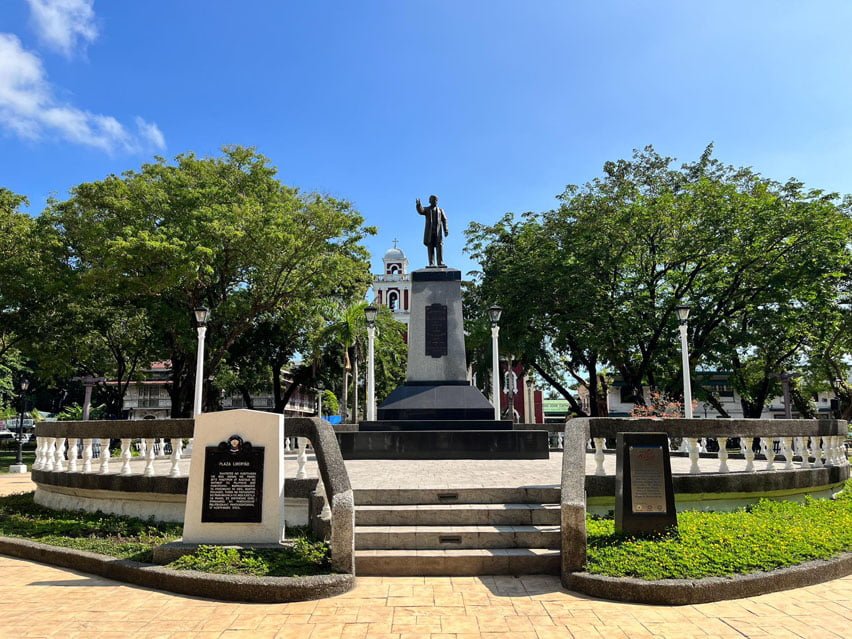 Plaza Libertad photo courtesy of Iloilo City Government Facebook page
Plaza Libertad photo courtesy of Iloilo City Government Facebook page
Plaza Libertad, the last stronghold of the Spaniards, where they ended their 333-year rule in the Philippines. Take a photo by the old train engine from Panay Railways, constructed in the 1900s to span various parts of Iloilo province all the way up to Roxas City and ceased operations in 1980s.
 Map of the Philippines during the time of the Spanish occupation in Museo Iloilo, photo by Trixie Reyna
Map of the Philippines during the time of the Spanish occupation in Museo Iloilo, photo by Trixie Reyna
Museo Iloilo, the first government-sponsored museum outside of Metro Manila, built in 1971. Located within the Iloilo Provincial Capitol Complex along Bonifacio Drive, its gallery houses the works of Ilonggo artists and religious and historical artifacts of the region, some dating back to Pre-Hispanic era. It showcases a variety of modern and antique Ilonggo paintings, architecture, weaponry, and armory, as well as a mini library and photo gallery.
Jaro
2. Offer your intentions to the miraculous Nuestra Señora de la Candelaria at Jaro Cathedral
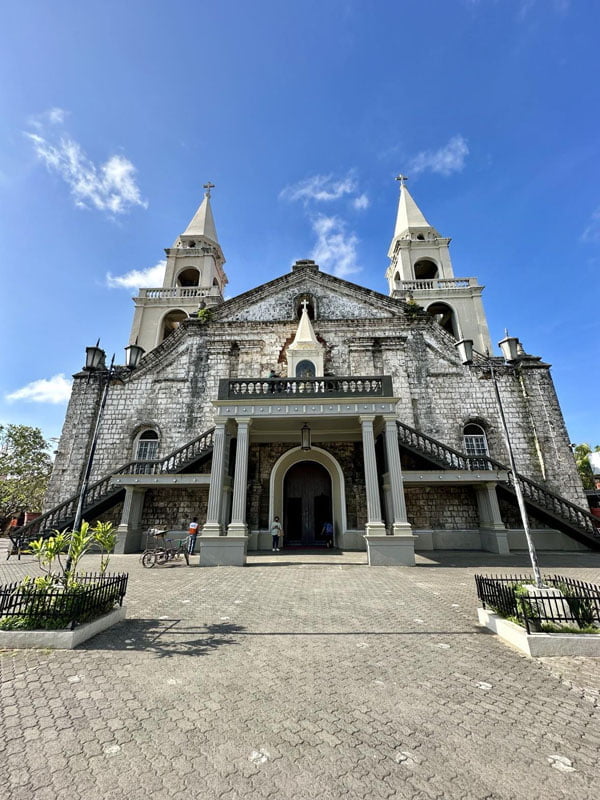
Visitors frequent the outdoor terrace of the National Shrine of Our Lady of the Candles to pray to the only female image in a Spanish-era church filled with male religious statues. According to folklore, this miraculous image of Virgin Mary was found by fishermen in Iloilo River. It used to be small yet heavy, and has grown so big, they had to move it to a raised pedestal outside the cathedral. From this terrace, you can also take a good photo of the cathedral’s 270-year-old belfry, which stands across Plaza Rizal Street at Jaro Plaza.
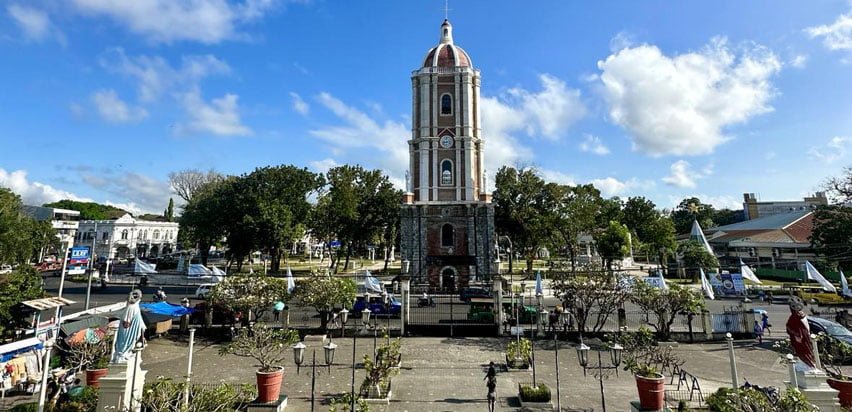
3. Sweets shopping at Original Biscocho Haus
A trip to Iloilo will not be complete without hoarding confections from one of its most popular pasalubong shops. Biscocho Haus is known for local confections like Iloilo’s famous biscocho (toasted and buttered slices of bread sprinkled with sugar), pinasugbo (sliced, fried, and caramelized bananas), barquillos (crispy rolled wafer, great with ice cream), galletas (local biscuits with prominent egg flavor), and butterscotch. The main branch is located along Lopez Jaena St., close to Jaro Cathedral, although it also has various stores and kiosks around the city.
4. History appreciation—and potential ghost hunting—at Casa Mariquit
View this post on Instagram
Tour this beautiful yet eerie 200-year-old ancestral residence along Santa Isabel St. in Jaro for a trip down memory lane with a bit of thrill. What used to be the home of the wife of former Philippine Vice President Fernando Lopez Sr. is filled with well-preserved historical photographs, memorabilia, and furniture. Visitors who enjoy exploring supposedly haunted places should look out for photographs whose subjects’ eyes seem to follow you around. Some claim that if you take a flash photo of the mosquito net-covered bed of the house’s deceased mistress, you might see her shadow, reclining or sitting up in bed. The caretaker also calls visitors’ attention to the prayer room, which supposedly has a strange magnetic pull, and the chilly basement.
Molo
5. Visit Molo Church and the “Athens of the Philippines”
One of the Philippines’ most beautiful churches is Sta. Ana Parish, more popularly known as Molo Church, fronting Molo Plaza along San Pedro St. Built in 1831 in the gothic renaissance-style, it is dubbed the “feminist church” of Iloilo because of the all-female religious images it houses. Single women can supposedly pray here to meet a partner.
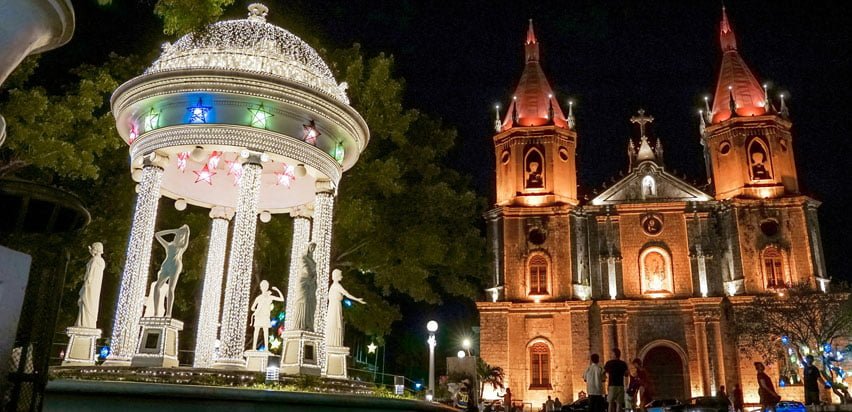
Molo Plaza, meanwhile, features statues of Greek gods and goddesses, supposedly to mark how Molo is dubbed the “Athens of the Philippines,” what with the educational institutions there during Spanish times and because it produced a lot of great Filipino professionals and public officials.
6. Pasalubong shopping, coffee, and dessert at Molo Mansion
Across the street from Molo Plaza, along Locsin Street, is the former Yusay-Consing Mansion, with its sprawling grounds, beautiful facade, and grand front steps. This once-abandoned heritage house has been restored into a tourist attraction and souvenir shop, with several al fresco snack and local coffee kiosks at the backyard (it now claims to be “The Home of Iloilo’s Arts, Crafts, and Home-Grown Businesses”). The souvenir shop at the ground floor is managed by SM’s Kultura, where you can find local handicrafts, woven fabrics, statement bags and accessories, hats, jewelry, souvenir shirts, and the ubiquitous ref magnets and key chains. It’s open daily from 10AM to 8PM.
Villa de Arevalo
7. Say a little prayer to the third oldest Sto. Niño image in the Philippines on the way to Villa Beach
View this post on Instagram
Not a lot of people know that the third oldest Sto. Niño in the Philippines can be found at the Archdiocesan Shrine of Sto. Niño De Arevalo along Arroyo St. in Villa Arevalo, brought by the Spaniards in 1581. (In case you were wondering, the oldest is in Cebu, brought there by the Spaniards in 1521; followed by the one in Tondo, Manila, enshrined there since 1572.)
After offering your intentions and basking in a bit of religious history, head to Villa Beach, the site of another popular event in Iloilo City: the Paraw Regatta, where colorful sailboats traverse the straits between Iloilo City and Guimaras, usually held every February.
View this post on Instagram
Along Villa Beach, you’ll find two must-try restaurants in Iloilo City: Breakthrough Restaurant, known for their delicious lechon and wide variety of arguably the best fresh seafood dishes you’ll have in Iloilo—think crabs, prawns, oysters, and various fish; and Tatoy’s Manokan, famous for their native lechon manok (roast chicken), also seafood (especially oysters), and other local dishes. Both offer paluto, where you pick your seafood and have it cooked a certain way, whether smothered in butter and garlic, steamed, grilled, fried, or kinilaw (marinated raw in vinegar, similar to ceviche), among others.
8. Ancestral home tour (with a side of delicious Pancit Molo) at Camiña Balay Nga Bato
In Iloilo City, sightseeing is almost always tied to food-tripping, in case you haven’t already noticed. This stone house owned by the Avanceña-Camiña clan (the English translation of its Hiligaynon name) has a museum, a restaurant, and a souvenir shop, open daily from 8AM to 5PM.
The beautiful 150-year-old heritage residence along Osmeña St. in Villa Arevalo reportedly serves the best Pancit Molo in town, and is also famous for their hot chocolate (Tsokolate E). Soak in more of Iloilo’s rich history and culture from the Camiña clan’s collection of furniture, art, and memorabilia from circa 1860s.
Don’t forget to call ahead if you plan to dine (+63947-8911467 or +6333-3363858). The fee of P200/pax for a minimum of five persons includes a tour, tsokolate de batirol (hot chocolate), homemade biscuits, and a bowl of Pancit Molo. You can also host bigger banquet-style events here. Before you leave, shop unique pasalubong like tablea (a ball or disc of ground cacao beans), batirol (a wooden tool used for mixing local hot chocolate), and native woven fabrics.
Mandurriao
9. Enjoy a leisurely sunset stroll along Iloilo River Esplanade
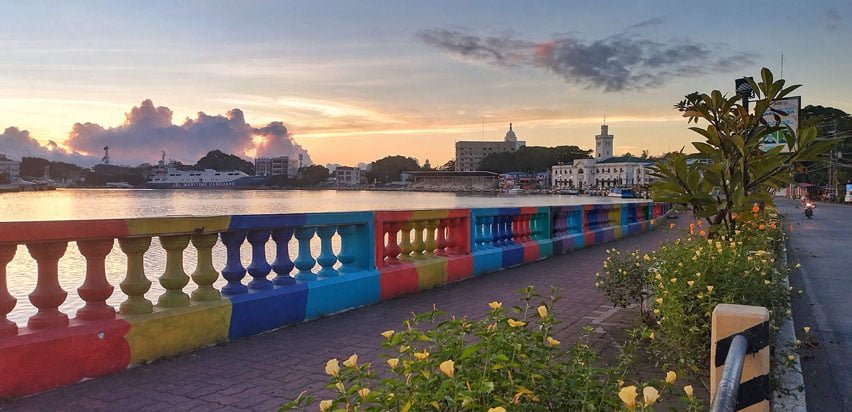
Locals and tourists alike flock to this popular long city landmark to jog and walk. It’s not unusual for you to see locals dancing or doing yoga and other forms of exercise in one of this landscaped path’s many nooks.
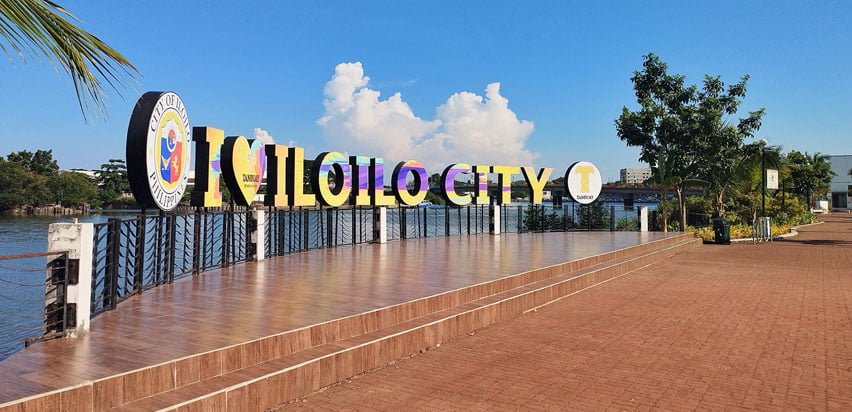 Iloilo River Esplanade photo by Davy Jones Canaway Tayco Estrellanes via Iloilo City Government Facebook page
Iloilo River Esplanade photo by Davy Jones Canaway Tayco Estrellanes via Iloilo City Government Facebook page
There are lots of backdrops on which to capture memories of your trip with loved ones, from the beautiful plants and mangroves lining the walk and colorful street art to the river that sparkles golden during sunset—take photos from one of the bridges that connect the riverbanks. For dining options, head to Riverside Boardwalk, which features a row of must-try restaurants that face the Iloilo River and Esplanade.
10. Get artsy at ILOMOCA and Festive Walk Parade
View this post on Instagram
Iloilo Museum of Contemporary Art (ILOMOCA) opened in 2018 as the first art institution in the Visayas region devoted to the works of Filipino and foreign modern and contemporary artists. It has 3,000sqm of space that features five exhibit rooms and a merchandise shop, housed within Casa Emperador, located in the 72-hectare Iloilo Business Park. The Hulot Exhibit on the first floor is dedicated to exhibitions of local and international artists. The Gallery at the second level is for rotating shows, like those highlighting the Ilonggo art scene and Filipino sculpture. It’s open Tuesday to Sunday from 10AM to 6PM.
View this post on Instagram
For more pretty spots for travel photos and perhaps to grab a bite, explore Festive Walk Parade, a 1.1-kilometer-long, 22-meter-wide shop-and-dine strip. The highlight of this area is K-Town (Korea Town), with colorful lanterns to match the just-as-colorful buildings lined with several Korean restaurants, cafes, and shops. They sometimes have live entertainment here on weekends and special events like the Dinagyang Festival while you enjoy a festive street fair vibe.
View this post on Instagram
How to get there
Philippine Airlines, Cebu Pacific, and AirAsia offer several flights from Manila to Iloilo International Airport daily. The flight takes a little over an hour. There are also flights from Cebu, Davao, Puerto Princesa, and General Santos.
Take the earliest flight to arrive early and make the most of your trip. Also consider taking the last flight out of Iloilo. This will help you avoid the traffic congestion on the way to and from the airport during rush hour. The city proper is around 30-45 minutes from the airport, accessible by taxi, jeepney, bus, or private vehicles.
The best way to get around the city is by cab or jeepney. You can also book a car via the ride-hailing app Grab. The city likewise promotes the use of bikes, in an effort to improve the growing traffic problem, which is why it was recently named one of the top bike-friendly cities in PH. There are several van rental companies operating in Iloilo City, with the most popular one being Southwest (which also has transfers to and from Boracay).
